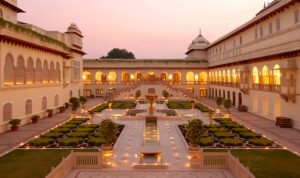Kathak is not just a dance; it’s a narrative woven through rhythm, movement, and expression. Originating from the northern parts of India, Kathak is known for its graceful spins, intricate footwork, and the ability to tell stories through movement. Whether performed in a temple or on a grand stage, Kathak draws the audience into a world where every gesture speaks volumes.
From Temple Stories to Royal Courts
The word Kathak comes from the Sanskrit word katha, meaning “story,” and kathakar, meaning “storyteller.” In its earliest form, Kathak was performed by wandering bards who traveled from village to village narrating stories from Indian epics like the Mahabharata and Ramayana through dance, music, and expressive gestures.
As time passed, Kathak evolved significantly. During the Mughal era, it moved from temples to royal courts, where it absorbed Persian influences—leading to more intricate costumes, expressive facial drama, and a refined, graceful style. This fusion gave Kathak its unique identity among Indian classical dances.
The Signature Style
Kathak stands out for its:
Chakkars (spins) – swift, smooth pirouettes performed with incredible balance.
Tatkar – complex footwork with ankle bells (ghungroos) that accentuate rhythmic patterns.
Abhinaya – expressive storytelling through facial expressions and hand gestures.
Layakari – mastery of rhythm and timing, often performed in challenging time cycles.
Unlike some other classical forms, Kathak is more fluid and dynamic, switching between fast-paced rhythmic footwork and slow, expressive storytelling.
Gharanas: Styles That Define the Dance
Kathak has three major gharanas or schools, each with its own unique style and lineage:
Lucknow Gharana – known for grace, subtlety, and expressive abhinaya.
Jaipur Gharana – focuses on strong footwork and complex rhythm patterns.
Benaras Gharana – blends features from both, emphasizing devotional themes.
Each gharana brings something different to the performance, enriching the diversity within the Kathak tradition.
Music and Accompaniment
Kathak is usually performed to Hindustani classical music. The live orchestra often includes instruments like the tabla, sarangi, harmonium, and pakhawaj. The synergy between dancer and musicians, especially the tabla player, creates a captivating rhythmic dialogue during live performances.
Icons of Kathak
Kathak has been shaped and popularized by legendary artists such as:
Birju Maharaj – the most celebrated name in Kathak, known for his brilliance in both performance and choreography.
Sitara Devi – the ‘Queen of Kathak’, who brought boldness and charm to the dance.
Saswati Sen, Kumudini Lakhia, and others who have kept the tradition alive while adapting it for modern audiences.
Kathak in the Modern World
Today, Kathak is performed not only on classical stages but also in films, contemporary productions, and international festivals. It has found a place in the global arts scene while still staying rooted in its traditional values.
Why Kathak Continues to Inspire
Kathak is more than just technique — it’s a celebration of expression, rhythm, and heritage. It connects the past with the present, using movement as a language that transcends barriers. Whether telling stories of love, divinity, or daily life, Kathak remains a powerful form of expression that continues to mesmerize audiences worldwide.









